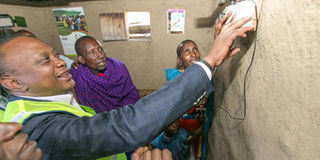Access to electricity boosts security and tourism in Coast

President Uhuru Kenyatta switching on power at Mzee Parsayian ole Sadera's home in Olngenchemi village during the launch of the Last Mile Connectivity project in Narok County. PHOTO | PSCU
What you need to know:
The project, alongside the street lighting initiative by Kenya Power, is driving the crime rate down besides boosting tourism in the Coast region.
The first phase of the three-phase project was launched on April 3, 2016 and took 18 months to be completed.
The existing distribution transformers which stood at 5,320 were maximized to reach an estimated 314,200 households across the 47 counties.
Crime rate has reduced while business continues to thrive at the Coast courtesy of a National government project that has linked close to one million households to the power grid.
The Sh18.5 billion Last Mile Connectivity project, a joint initiative between the government of Kenya and World Bank, was aimed at increasing electricity access to Kenyans across the country.
The project, together with the street lighting initiative by Kenya Power, has reduced crime rate besides increasing small scale trade and boosting tourism in the region.
Ms Janet Mtsanze, 52, a resident of Muoroto slums in Mombasa County, is counting her blessings after her small house was lit up courtesy of the Last Mile Connectivity project.
“I had very few tenants in my rental houses because it lacked electricity but when it was connected to the power grid, things have changed and there is no room left. It is a major development shift and people can associate or link it with work of the current government,’’ she said.
SECURITY IMPROVES
A few meters away is another tenant Ms Saumu Charo, who opines that security has improved in the area since the inception of the project and now there is free movement of residents.
“Security which used to be a major challenge when darkness set is no longer an issue since the area is well lit and people can go about their businesses day and night ,’’ she said.
The story is the same for Mr Iddi Tsuma, a local fisherman who is now able to store his fish after landing at the local beach within the sprawling slum village.
“I have power connected to my small store where I have a refrigerator from where I store fish before taking them to the market. Unlike before when my catch would go to waste since there was no cold storage facility here,’’ he said.
DISTRIBUTION OF TRANSFORMERS
The first phase of the three-phase project was launched on April 3, 2016 and took 18 months to be completed. The existing distribution transformers which stood at 5,320 were maximized to reach an estimated 314,200 households across the 47 counties, located within 600 meter radius.
The benefits brought by the project include connectivity to power grid, an increase in economic activities and reduction of electricity connection cost from Sh35,000 to Sh15,000.
Most homes, which used to rely on kerosene as a source of light, now have access to electricity due to the reduction in cost of electricity.
Kenya Power says there has been a 46 per cent rise in the number of new customers in the last two years raising the number of those connected to more than 3 million.
The national government targets to have at least 70 per cent of Kenyan households connected to electricity by the end of the year and achieve universal connectivity by 2020.





